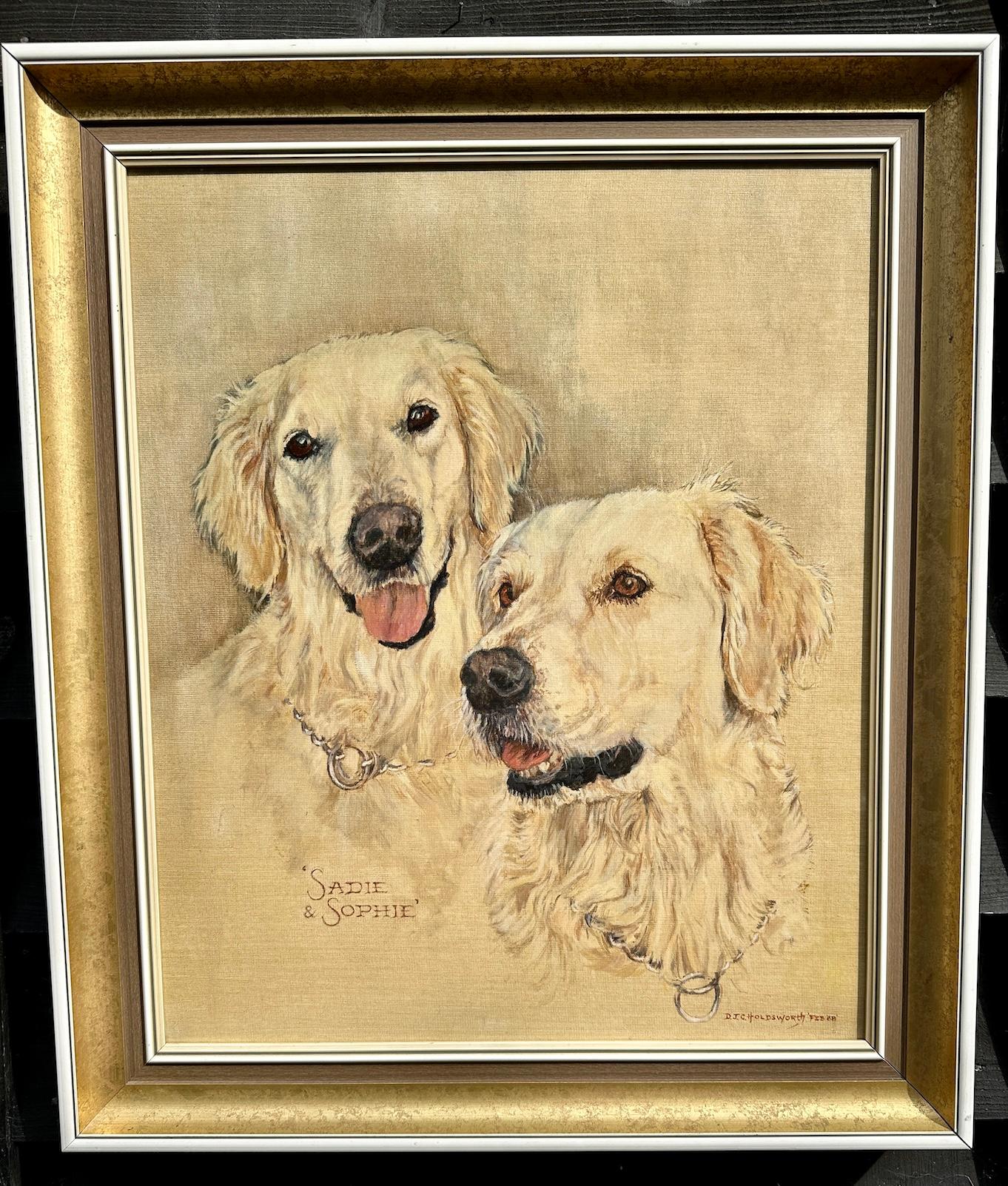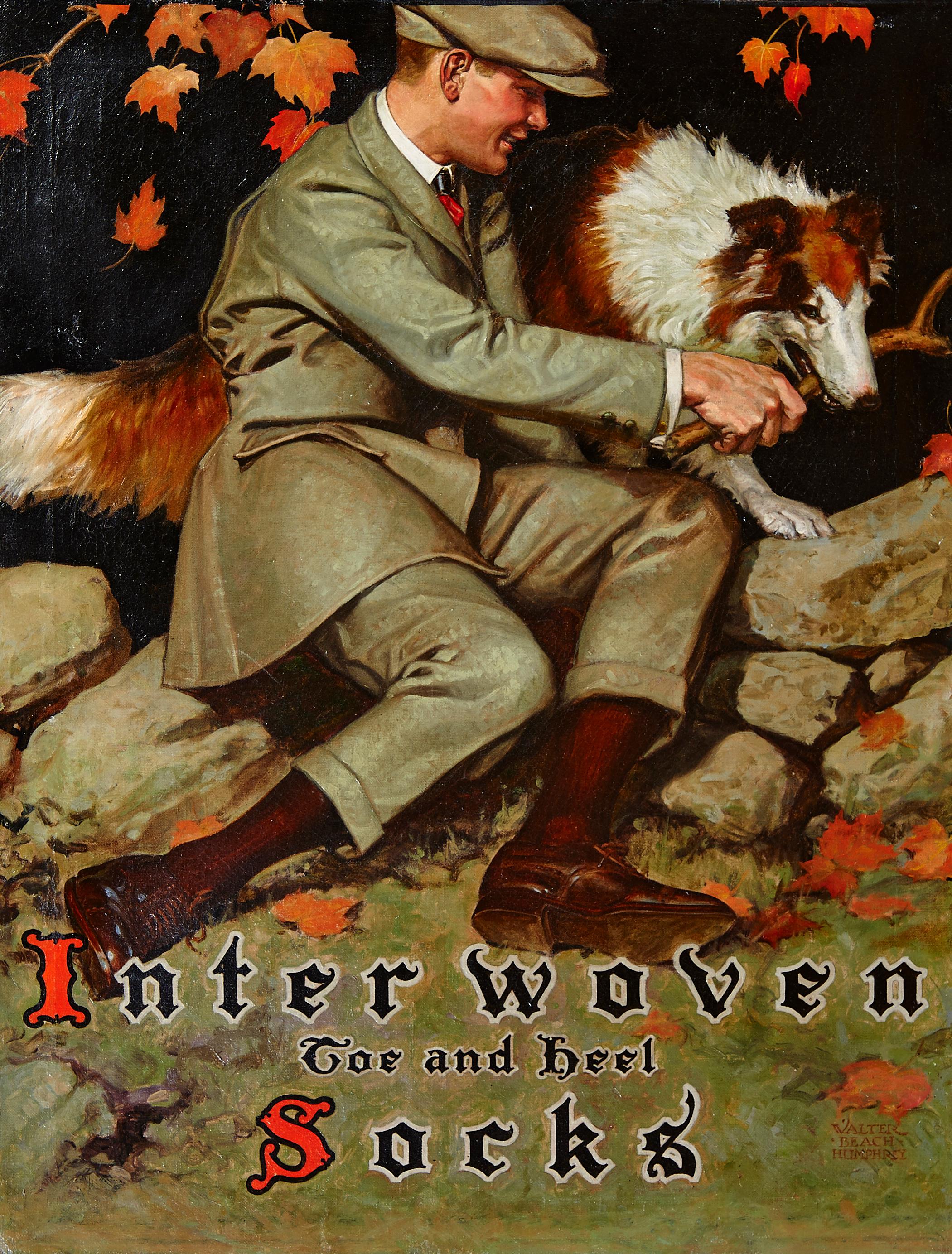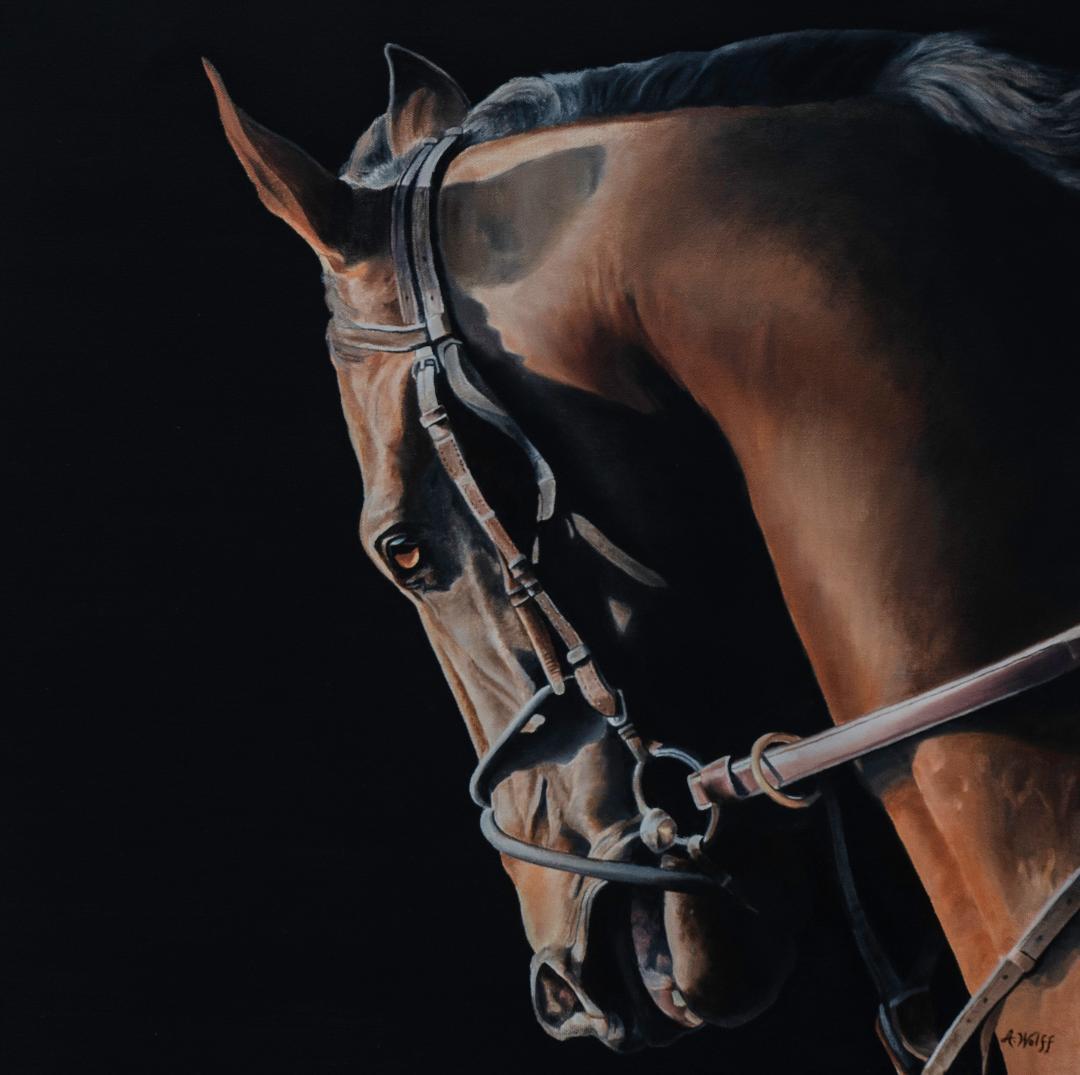Orovida PissarroFather, Daughter and Horse by Orovida Pissarro - Oil painting1947
1947
About the Item
- Creator:Orovida Pissarro (1893 - 1968)
- Creation Year:1947
- Dimensions:Height: 23.63 in (60 cm)Width: 28.75 in (73 cm)
- Medium:
- Movement & Style:
- Period:
- Condition:
- Gallery Location:London, GB
- Reference Number:1stDibs: LU261210596122
Orovida Pissarro
Orovida Pissarro, the only child of Lucien and Esther Pissarro, was the first woman in the Pissarro family to become a professional artist and the first Pissarro of her generation to take up painting. Born in Epping, England, in 1893, she lived and worked predominantly in London, where she was a prominent member of several British arts clubs and societies.
Orovida first learned to paint in the Impressionist style from her father and, after a brief period of formal study with Walter Sickert in 1913, she renounced formal art schooling.
Throughout her career, Orovida always remained outside mainstream British art movements. Much to Lucien's disappointment, she soon turned away from naturalistic painting and developed an unusual style that combined elements of Japanese, Chinese, Persian and Indian art. Her rejection of Impressionism, which, for the Pissarro family, was a way of life, and her simultaneous decision to drop her famous last name and use simply Orovida as a nom de peintre, reflected a desire for independence and distance from the family legacy, of which she nevertheless remained proud.
Orovida's most distinctive works are her paintings from the 1920s and 1930s in gouache (she called her mixture body color) and tempera, applied in thin, delicate washes to silk, linen, paper or gold leaf and embellished with brocade borders. These elegant and richly decorative works generally depict non-Western subjects, for example: Mongolian horseback riders, African dancers and Persian princes, often engaged in activities such as dancing or hunting rituals.
The second half of Orovida's painting career is marked by a dramatic change in both style and subject matter. In the mid-1940s, she began to embrace contemporary subjects from everyday life and returned to a more naturalistic style. Her new style was more suited to oils, and thus, she returned to that medium.
Over the course of her life, Orovida was aware of the mixed blessing of having famous artists in the family; not only a grandfather and father but also four uncles, and towards the end of her life, she was instrumental in developing the Pissarro family archive that her mother had established at the Ashmolean Museum in Oxford.
(Biography provided by Stern Pissarro Gallery)
- ShippingRetrieving quote...Ships From: London, United Kingdom
- Return PolicyA return for this item may be initiated within 7 days of delivery.
- Bretonne à la Vache by Georges Manzana Pissarro - Oil on panelBy Georges Henri Manzana PissarroLocated in London, GBBretonne à la Vache by Georges Manzana Pissarro (1871-1961) Oil on panel 54 x 65 (21 ¹/₄ x 25 ⁵/₈ inches) Signed and dated lower left, Manzana 1929 Pissarro Inscribed lower left, Pon...Category
1920s Post-Impressionist Animal Paintings
MaterialsPanel, Oil
- Tom Cat by Orovida Pissarro - Cat oil painting, 1961By Orovida PissarroLocated in London, GBTom Cat by Orovida Pissarro (1893-1968) Oil on canvas 51 x 61 cm (20 ¹/₈ x 24 inches) Signed and dated lower left Orovida 1961 Provenance Collection of Carel Weight Private collecti...Category
1960s Modern Animal Paintings
MaterialsCanvas, Oil
- Animal painting by Orovida Camille Pissarro titled 'Exercising Ponies'By Orovida PissarroLocated in London, GB*UK BUYERS WILL PAY AN ADDITIONAL 20% VAT ON TOP OF THE ABOVE PRICE Exercising Ponies by Orovida Camille Pissarro (1893-1968) Oil on board 101.5 x 76 cm (40 x 30 inches) Signed and dated lower right Orovida 1954 Provenance Estate of Orovida Pissarro With John Bensusan-Butt, cousin of the artist Sotheby's London, 12th October 1988 G Hassell, 25th November 1988 With John Noott, 10th June 1992 Literature K L Erickson, Orovida Pissarro: Painter and Print-Maker with A Catalogue Raisonné of Paintings, (doctoral thesis), Oxford, 1992, Appendices, no. 161 (illustrated) Exhibitions London, Bowmore Gallery, Women in Art 1850-1989, 2nd-11th November 1989 Fort Lauderdale, Museum of Art, Camille Pissarro and his Descendants, January-April 2000, no.123 This work was included in the above important museum exhibition and a catalogue of the Fort Lauderdale museum show will be included with this painting. Biography Orovida Camille Pissarro, the only child of Lucien and Esther Pissarro, was the first woman in the Pissarro family to become a professional artist and the first Pissarro of her generation to take up painting. Born in Epping, England, in 1893, she lived and worked predominantly in London, where she was a prominent member of several British arts clubs and societies. She first learned to paint in the Impressionist style from her father and, after a brief period of formal study with Walter Sickert in 1913, she renounced formal art schooling. Throughout her career, Orovida always remained outside mainstream British art movements. Much to Lucien's disappointment, she soon turned away from naturalistic painting and developed an unusual style that combined elements of Japanese, Chinese, Persian and Indian art. Her rejection of Impressionism, which, for the Pissarro family, was a way of life, and her simultaneous decision to drop her famous last name and use simply Orovida as a nom de peintre, reflected a desire for independence and distance from the family legacy, of which she nevertheless remained proud. Orovida's most distinctive works are her paintings from the 1920s...Category
1950s Modern Animal Paintings
MaterialsOil, Canvas
- Tiger Surprises Black Buck by Orovida Pissarro - Animal paintingBy Orovida PissarroLocated in London, GB*UK BUYERS WILL PAY AN ADDITIONAL 20% VAT ON TOP OF THE ABOVE PRICE Tiger Surprises Black Buck by Orovida Pissarro (1893-1968) Oil on canvas 127 x 101.5 cm (50 x 40 inches) Signed and dated lower left Orovida 1960 Provenance The Leicester Galleries, London, circa 1965 Literature K L Erickson, Orovida Pissarro: Painter and Print-Maker with A Catalogue Raisonné of Paintings, (doctoral thesis), Oxford, 1992, Appendices, no. 195 (illustrated) Exhibition London, Royal Society of British Artists, 3rd-25th November 1960, no. 82 (possibly; titled Tiger Entangled) London, Royal Academy, 1961, no. 534 Colchester, The Minories, 3rd- 24th March 1962 London, The Leicester Galleries, 1965, no. 37 Artist biography Orovida Camille Pissarro, Lucien and Esther Pissarro’s only child, was the first woman in the Pissarro family as well as the first of her generation to become an artist. Born in Epping, England in 1893, she lived and worked predominantly in London where she became a prominent member of several British arts clubs and societies. She first learned to paint in the Impressionist style of her father, but after a brief period of formal study with Walter Sickert in 1913 she renounced formal art schooling. Throughout her career, Orovida always remained outside of any mainstream British art movements. Much to Lucien's disappointment she soon turned away from naturalistic painting and developed her own unusual style combining elements of Japanese, Chinese, Persian and Indian art. Her rejection of Impressionism, which for the Pissarro family had become a way of life, together with the simultaneous decision to drop her famous last name and simply use Orovida as a ‘nom de peintre’, reflected a deep desire for independence and distance from the weight of the family legacy. Orovida's most distinctive and notable works were produced from the period of 1919 to 1939 using her own homemade egg tempera applied in thin, delicate washes to silk, linen or paper and sometimes embellished with brocade borders. These elegant and richly decorative works generally depict Eastern, Asian and African subjects, such as Mongolian horse...Category
1960s Modern Animal Paintings
MaterialsCanvas, Oil
- Migrating horses by Orovida Pissarro - Animal paintingBy Orovida PissarroLocated in London, GB*UK BUYERS WILL PAY AN ADDITIONAL 20% VAT ON TOP OF THE ABOVE PRICE Migrating horses by Orovida Pissarro (1893-1968) Oil on canvas 71.1 x 81.4 cm (28 x 32 inches) Signed and dated l...Category
1950s Modern Figurative Paintings
MaterialsOil, Canvas
- Cat and Mouse by Orovida Pissarro - Animal paintingBy Orovida PissarroLocated in London, GBCat and Mouse by Orovida Pissarro (1893-1968) Oil on canvas 61 x 51 cm (24 x 20 ⅛ inches) Signed and dated lower centre Orovida 1948, altered by the artist in 1966 Provenance Royal ...Category
1960s Modern Animal Paintings
MaterialsCanvas, Oil
- 20th century English portrait of two Labrador Retriever dogs Sadie & SophieLocated in Woodbury, CT20th-century English portrait of two Labrador Retriever dogs Sadie & Sophie Owning a painting of two English Labrador Retriever dogs by D.J. Holdswor...Category
1980s Modern Animal Paintings
MaterialsCanvas, Board, Oil
- Interwoven Socks AdvertisementBy Walter Beach HumphreyLocated in Fort Washington, PAApproximate Date: 1920-1925 Medium: Oil on Canvas Signature: Signed Lower Right Size: 29.50" x 23.00" Interwoven Socks Advertisement Literatu...Category
1920s American Modern Animal Paintings
MaterialsCanvas, Oil
- Anne Wolff, "Morning Exercise", Photorealist Equine Portrait Oil on CanvasBy Anne WolffLocated in Saratoga Springs, NYThis equine racing portrait "Morning Exercise" by artist Anne Wolff is a 24x24 original oil painting on canvas. Depicted is a profile view of a thoroughbred race horse against a blac...Category
2010s Photorealist Animal Paintings
MaterialsCanvas, Oil
- Anne Wolff, "Sunlight", Equine Portrait Oil Painting on CanvasBy Anne WolffLocated in Saratoga Springs, NYThis equine racing painting "Sunlight" by artist Anne Wolff is a 12x16 original oil painting on canvas. The black background adds a dramatic note to the painting, and contrasts the ...Category
2010s Photorealist Animal Paintings
MaterialsCanvas, Oil
- Jessica Leonard, "Across the Board", Black and White Equine Oil on CanvasBy Jessica LeonardLocated in Saratoga Springs, NYThis black and white equestrian piece, "Across the Board", by artist Jessica Leonard is a 16x40 oil painting on canvas featuring a portrait of horse with focus on the eyes. The dras...Category
2010s Realist Animal Paintings
MaterialsOil, Canvas
- Portrait of a Monkey with Wine Jug, Zacharias Noterman (Bel. Fr. 1824-1890)By Zacharias NotermanLocated in SANTA FE, NMPortrait of a Monkey with Wine Jug Zacharias Noterman (Belgium & France 1824-1890) Initialed "Z N" l.r. Oil on board 8 x 6 inches PROVENANCE: Galerie Tamenaga, Paris (label verso); Louvre des Antiquaires, Paris; Berman Swarttz, Los Angeles, California, Marcella Swarttz, Beverly Hills, California 8 x 6 inches Zacharias Notermann (1820 in Ghent – 1890 in Paris) was a Belgian painter and printmaker who specialized in scenes with monkeys engaging in human activities (the so-called singeries), as well as in paintings of dogs. He also produced images and scenes of traveling circuses. Zacharias Noterman was born in Ghent in the family as the son of an artist-decorator. He was originally trained by his older brother Emmanuel Noterman, genre and animal painter active in Antwerp. Noterman continued his art education at the Academy of fine arts Antwerp. Zacharie Noterman...Category
Mid-19th Century Realist Animal Paintings
MaterialsCanvas, Oil, Board






